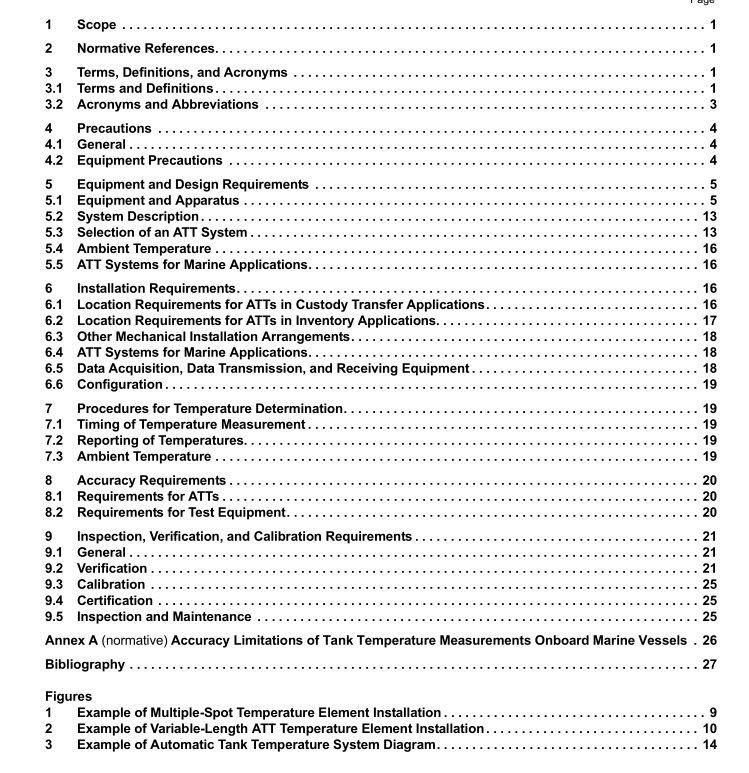API MPMS 7.3 pdf download

API MPMS 7.3 pdf download Manual of Petroleum Measurement Standards Chapter 7.3 Temperature Determination—Fixed Automatic Tank Temperature Systems
The operational range limits, as well as the ambient impact on the measurement accuracy of all equipment as part ofa temperature measurement system shall be clearly stated and provided by the equipment manufacturer.
The design and installation of ATTs may be subject to the approval of the national measurement organization and/orclassification societies,who may have issued a general type approval for the design of the ATT for the particularservice for which it is to be employed. Type or pattern approval is normally issued after an ATT has been subjected toa specific series of tests and is subject to the ATT being installed in an approved manner.
Security—ATT systems should provide security to prevent unauthorized adjustment. ATT systems used in fiscallcustody transfer application should provide facilities to allow sealing for calibration adjustment.
5 Equipment and Design Requirements
5.1 Equipment and Apparatus
5.1.1 Temperature Sensors
ATTs generally use one of the following types of temperature sensors:
-resistance temperature detector(RTD);
-thermocouple.
These devices are usually housed in metal probes that normally mount into thermowells (spot ATTs) or protectiontubes(multi-spot or variable length ATTs).For spot ATTs, the probes are generally tip-sensitive. Thus, the probesshall be securely seated in the bottom of the thermowell for optimum heat transfer. Spring-oaded or adjustable-lengthprobes are recommended.
The wiring to the probe is critical because of the low signal levels of the devices. These devices should be installed asrecommended by the manufacturer for best accuracy.These sensors require linearization that is typicallyaccomplished within the associated transmitter.Each type of sensor requires its own unique circuit.
The selected sensor shall meet the requirements given in Table 4.
5.1.1.1 Resistance Temperature Detectors
The resistance temperature detector (RTD) is typically made of platinum although other metals such as copper maybe used,which is encapsulated in protective material to guarantee long term stabilty. The sensing element itselfshould be packaged in an enclosure suitable for the application and installation (typically this is made out of stainlesssteel). A suitable electronic circuit can be used to measure the transducer resistance by means of a small current (toprevent self heating) and convert the value into a corresponding temperature.
For platinum RTD temperature sensors standards such as IEC 607518land ASTME1137[7 are available whichspecify accuracy and performance requirements. These standards cover requirements for various types of testingand define different classes or grades corresponding to different tolerance requirements, as well as mathematicalexpressions characterizing the temperature-resistance relationship.Sensors produced according to these standardsresult in the use of either classified or characterized 1 sensors with a stable and well defined relationship betweenoperating temperature and expected tolerances.
The use of classified or characterized sensors in compliance with such standards is optional, but for certainapplications the added accuracy may be warranted.
RTDs are recommended for custody transfer applications because of their accuracy, responsiveness, long life, andthe stability of their output characterization over time.An RTD is less subject to electrical interference and errorscaused by changes in the properties of lead-in wires than thermocouples.
When selecting an RTD,consider three or four-wire RTDs as they allow compensation of the (temperaturedependent) lead wire resistance. The length of the temperature sensitive portion of a spot ATT sensor should notexceed approximately 100 mm (4 in.).
5.1.1.2 Thermocouples
Thermocouples are temperature-sensitive devices consisting of a pair of dissimilar metals so arranged that theelectromotive force(EMF) produced by the couple depends on the difference in temperature between the hot andreference junctions of the metals. There are many different types of thermocouples each with their own measurementrange, encompassing temperatures from about-150 °℃ (-300 °F) to about 1,300 °C(2,300 °F).
Electronically compensated single-junction thermocouples shall not be used for custody transfer measurement due tothe following:
-they suffer from drift and corrosion as they age;
-the millivolt signal is quite low and subject to electrical interference;
– the length, composition and condition of the thermocouple lead wires affects accuracy.
Other thermocouple systems that meet the requirements of Section 8 may be used for custody transfermeasurements.
5.1.1.3Other Temperature Sensors
Other types of temperature sensors(e.g. thermistors, semiconductors, etc.) are also available and may be suitable forcustody transfer purposes provided they meet the performance requirements of Section 8.









